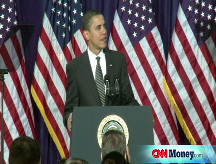Most affordable city in the nation
Indianapolis and New York City bookend the most affordable-least affordable list. Lower homes prices and interest rates fail to push sales higher.
NEW YORK (CNNMoney.com) -- Crashing home prices have led to the most affordable housing market in at least five years, according to the National Association of Home Builders/Wells Fargo Housing Opportunity Index released Thursday.
More than 60% of all U.S. homes sold during the last three months of 2008 were affordable - meaning that a family making the national median of $61,500 a year would pay 28% or less of their total income toward housing expenses.
At 62.4% affordable, the figure is up considerably from 56.1% in the previous quarter and 46.6% at the end of 2007, according to the report.
Topping the list of most affordable U.S. metro areas, which ranks areas with more than 500,000 in population, was Indianapolis. This is the city's 14th consecutive quarter in first place; it boasts a full 93% of all homes sold being affordable to median family households.
The least affordable was the New York City metro area, where only 13.9% of homes sold met the criteria.
In the fourth quarter, the national median home price fell to $190,000 from $205,700 in the previous-year period, according to a report issued last week by the National Association of Realtors. That combined with falling mortgage rates has made home buying the most affordable it has been since early 2002.
"Falling home prices and very favorable mortgage rates both contributed to the housing affordability gains we saw in the fourth quarter of 2008," NAHB Chairman Joe Robson, a homebuilder from Tulsa, Okla., said in a prepared statement.
That still wasn't enough to get moribund housing markets moving again. Existing homes sold at an annualized rate of 4.74 million in December, according to the National Association of Realtors, down from more than 7 million during the boom.
And a government report revealed that new home sales crashed to an annualized rate of 331,000 in December, the lowest since record keeping began in 1963.
"Worsening economic conditions, historically low consumer confidence and uncertainty about future home prices kept many qualified buyers on the sidelines," Robson said.
That affordability has improved so much does not necessarily make people go house hunting, according to Mike Larson, a real estate analyst with Weiss Research.
"You could argue that house affordability indexes are improving but that may not be the best way of defining whether it's a good time to buy," he said. "Concerns about the economy and whether they're going to still have a job have kept many homebuyers from stepping up to the plate."
During the boom, when house affordability plunged, buyers came out in droves. They were confident in the economy and afraid that home prices would soar out of reach. Today, just the opposite applies.
"Affordability is going to get even better," said Larson. "Home prices are not done falling. Buyers recognize this. There's no sense of urgency, and rightly so."
Indeed, according to Nicholas Retsinas, director of Harvard University's Joint Center for Housing Studies, affordability, which was a major factor in homebuying during the boom, no longer matters very much. In most parts of the United States, affordability has returned to where it was in 2002 or 2003.
"The new barrier is willingness to buy," he said.
That's why one major goal of President Obama's housing-rescue plan involves slowing foreclosures to stabilize housing markets and foster consumer confidence.
"If that happens, maybe people will start thinking, 'Hey, maybe prices won't go down tomorrow,'" said Retsinas.
Affordability in Indianapolis, the 33rd largest metro area in the United States with 1.7 million people, was buoyed by fairly high median income of $65,100 and rock-bottom home prices. The median price for a home sold during the quarter was just $103,000, according to the National Association of Home Builders report.
Those prices, combined with reasonable mortgage interest rates, make home-buying in the area a snap. A buyer of a median-priced home putting 20% down would pay only about $450 a month in mortgage expenses.
But even though house buying costs are reasonable, the city's weakening economy meant it did not escape the foreclosure plague. More than 20,000 homes, representing nearly 3% of the city, received a foreclosure filing of some kind in 2008, the 26th highest rate in the nation.
Other most affordable towns were: Warren, Mich. (89.6%); Youngstown, Ohio (89.4%); and Detroit (89.3%).
In the New York City metro area, home prices took a steep dive during the quarter, to $455,000 from $500,000 three months earlier. But even that was not enough to dislodge the city from its rank as the most unaffordable metro area in the land.
Median income in the area is $63,000, less than in Indianapolis and, with home prices more than four times higher than in the Midwestern metropolis, only 13.9% of the homes sold there were affordable to median income families.
That was still a major improvement from two years ago, when only 5.1% of homes sold during the fourth quarter of 2006 were affordable. And New York households have been barely brushed by foreclosure so far with only 0.71% receiving some kind of foreclosure filing during 2008.
Other least-affordable metro areas included San Francisco at 20.6%, where affordability improved greatly from 5.7% during the second quarter of 2007; suburban Long Island, where 25.5% were affordable; and Los Angeles, where 26.9% were.
Have you found a job recently? We want to hear from you. Send us an email and attach a photo. Tell us where you got hired and how you landed the job and you could be profiled in an upcoming story on CNNMoney.com. ![]()


